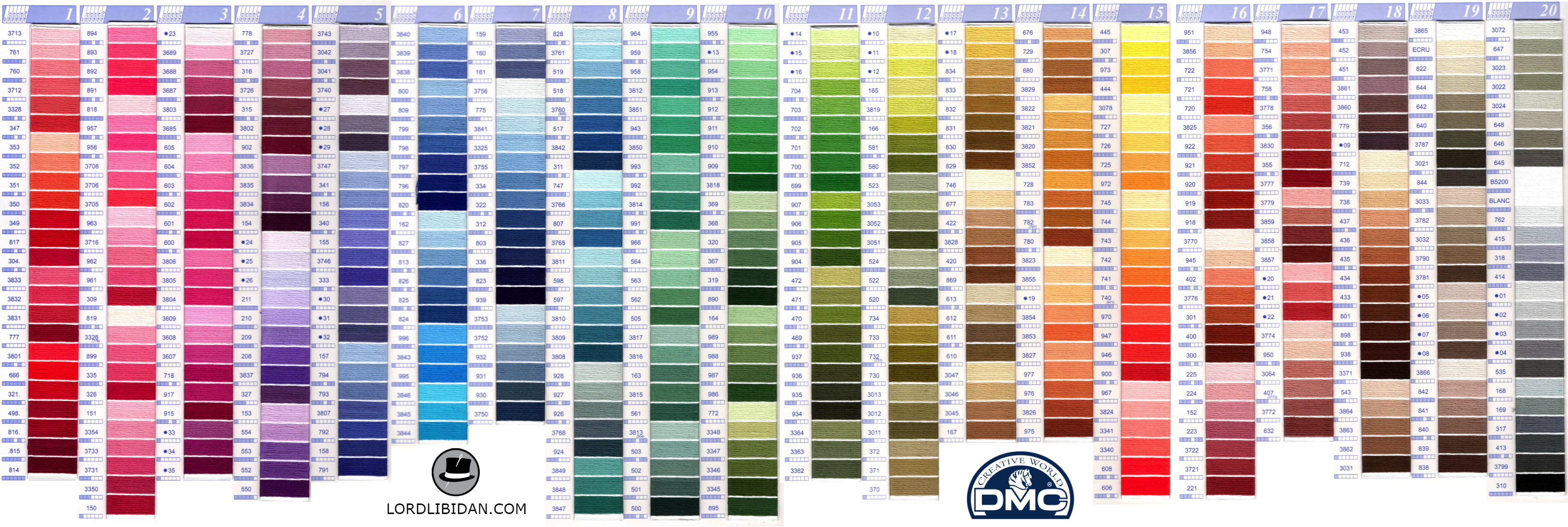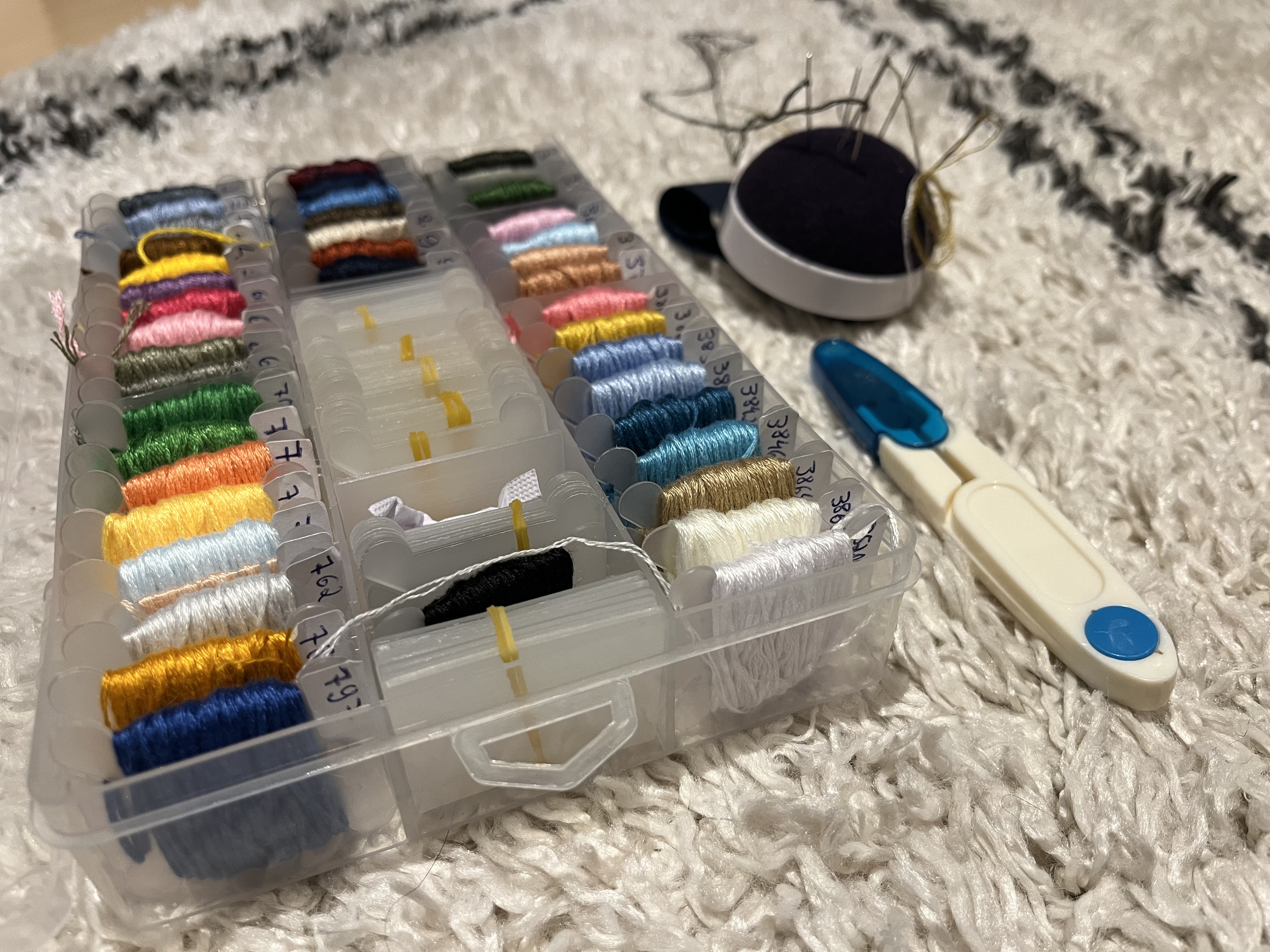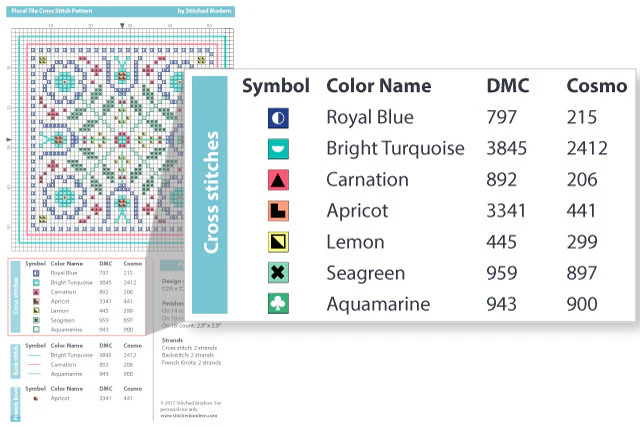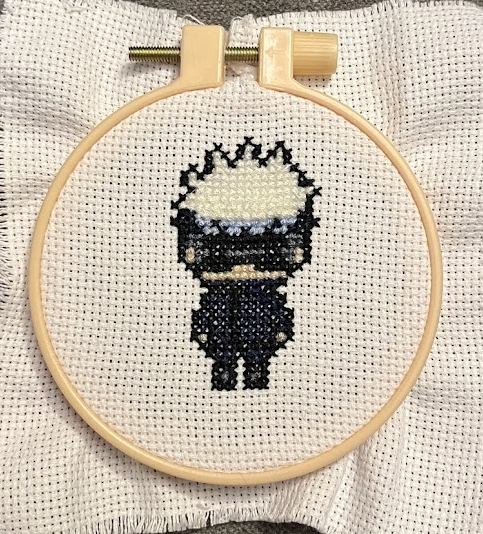I recently took up cross-stitch because it felt accessible and I wanted to try something hand-crafty. This hobby allows me to materialize my interests, particularly in pop culture, such as anime. Creating tangible pieces based on what I enjoy brings me satisfaction and a sense of accomplishment. I have only done small stuff, as, just like books, I need to feel like my goal is reachable to keep me motivated. Yet, this is something I'm working on personally and I'm hoping a longer cross-stitch project will help me in that.
Floss and strands
Floss is a type of thread made specifically for needlework. It's soft, glossy and comes in a variety of colors. The DMC color system is the standard for identifying these colors. Each DMC floss is assigned a unique number, making it easy to identify and match colors across patterns and projects.
 DMC color chart from LordLibidan.com.
DMC color chart from LordLibidan.com.
DMC occasionally releases new colors, expanding their extensive palette. Each piece of floss consists of six strands twisted together. The number of strands you use depends on the fabric and effect you're going for (see AIDA Cloth). I usually wind the colors I'm using onto bobbins and store it in a box. I write the colors in the bobbin and organize them in a way that I can always see their codes.
 My box with the color bobbins. I only keep the colors I'm currently using here.
My box with the color bobbins. I only keep the colors I'm currently using here.
Threading a needle
There are several ways to thread a needle. I mainly do two stand projects on a 14-count Aida and I prefer the loop approach:
- Cut enough floss for what you need to do but never more than 50cm;
- Separate the floss into a single strand;
- Fold the strand in half
- Thread the loop end through the needle.
- Make your first stitch, pass the needle through the loop, and pull tight to secure.
2024-07-24-cross-stitch-threading-loop-method.jpg
In step 1, 50cm may actually be too much. While it is tempting to just use a big strand if you're filling in a color that will use that much, truth is a big strand is a pain to handle while stitching. Additionally, a longer stand will get knots way more easily while handling and unmaking them is not fun.
Hoops
There are circular, elliptical, rectangular hoops and they help keep the cloth stretched. These are optional and hand-stitching can actually be a lot faster.
 A set of hoops I bought and use regularly.
A set of hoops I bought and use regularly.
AIDA cloth
Aida is a common fabric for cross-stitch, characterized by its open, even-weave structure which makes it easy to count and see where to place stitches. I usually use a big 14-count AIDA and cut it up according to my pattern size. In 14-count it is also usual to use 2 strands, which I achieve by folding a big strand in the loop threading method. You can still go for:
- Higher-count Aida (e.g., 18 or 20): using 1 strand for finer, more delicate stitches.
- Lower-count Aida (e.g., 11): using 3 or more strands for better coverage. I've bought a large Aida fabric and cut it for each project as needed.
Patterns
My first patterns came with a beginner kit—simple, small designs with a hoop to help me practice handling threads and stitching. From there, I started searching the web for patterns related to my interests and I quickly ran into some simple patterns of Gojo Sato or a Digivice. I prefer clean, simple designs that elegantly capture the essence—whether it’s a character or a specific aesthetic. Minimalistic patterns feel efficient and refined, using fewer strokes to highlight just the right details without overwhelming with excess. Overly complex patterns just feel like pixelated pictures.
I’ve found free patterns on sites like Lord Libidan and Pinterest, but I’ve also discovered hidden gems on Cross Stitch Quest. Etsy and Daily Cross Stitch have amazing designs, and I'm sure I'll end up buying a few.
If a pattern has everything you need t is usually pretty straightforward to follow. This guide from stitched modern is pretty comprehensive, but I feel like this is enough for anyone to understand:

As long as you have color codes and the actual pattern you're good to go. Patterns usually use symbols to identify each color on the grid.
Learned with practise
Here I go through some learnings from practise:
Stitching Direction
For a clean, uniform look, always keep your stitches consistent. I usually go with: bottom-left to top-right diagonal, then cross it with bottom right to top-left. Keep this for every stitch gives the finished piece a smooth and polished texture, especially under light.
Don't overstretch
While I've read about it I only learned about the importance of this once I made this mistake. Tightening the floss too tight will warp the fabric and distort the stitches. It's still important to pull just enough tension to keep the thread next to the cloth.
Shorter floss actually saves time
I mentioned this earlier, but this was also something I learned along the way. Using longer strands longer might seem like a time-saver (you won't have to thread the needle as often), but they’re harder to manage and prone to tangling or knotting. I've found something around 50cm is ideal for me, and threading the needle is something pretty easy to do, so no need to complicate things.
Drawing a grid on the cloth;
Lightly marking a grid on your Aida cloth can be a game-changer. I've done it with a pencil before, which can't be removed as easily, but as long as I don't overstretch, the floss will actually cover the grid fully. I usually grid on every 10 stitches, both horizontally and vertically. It really helps so much in following the pattern accurately.
Mistakes Happen
Even with "Count twice, stitch once" in mind, mistakes happen. I've learned to embrace undoing mistakes as part of the hobby. I’ve learned to embrace undoing them as just another step in the hobby. Sometimes, mistakes are easy to fix: working backwards the stitches with the needle may just be enough. Other times, I've noticed errors that are so minor they don’t stand out in the finished piece. In those cases, I've decided it’s not worth the trouble of undoing and left them as they were.
My Works
Here is some of the stuff I've done


Final remarks
This entry serves as my Zettelkasten for cross-stitching, with a few personal adaptations. It’s a live document that I continue to update whenever I come across new insights or techniques.
Cross-stitching has been a rewarding experience. Starting from scratch and developing proficiency has been both humbling and enjoyable. Patience has played a significant role, but the process has been manageable— even when it felt challenging. Unlike with other activities, such as gaming or reading through rough parts of a book, I’ve found that cross-stitching keeps me coming back.
I look forward to updating this entry with more projects and progress in the future!